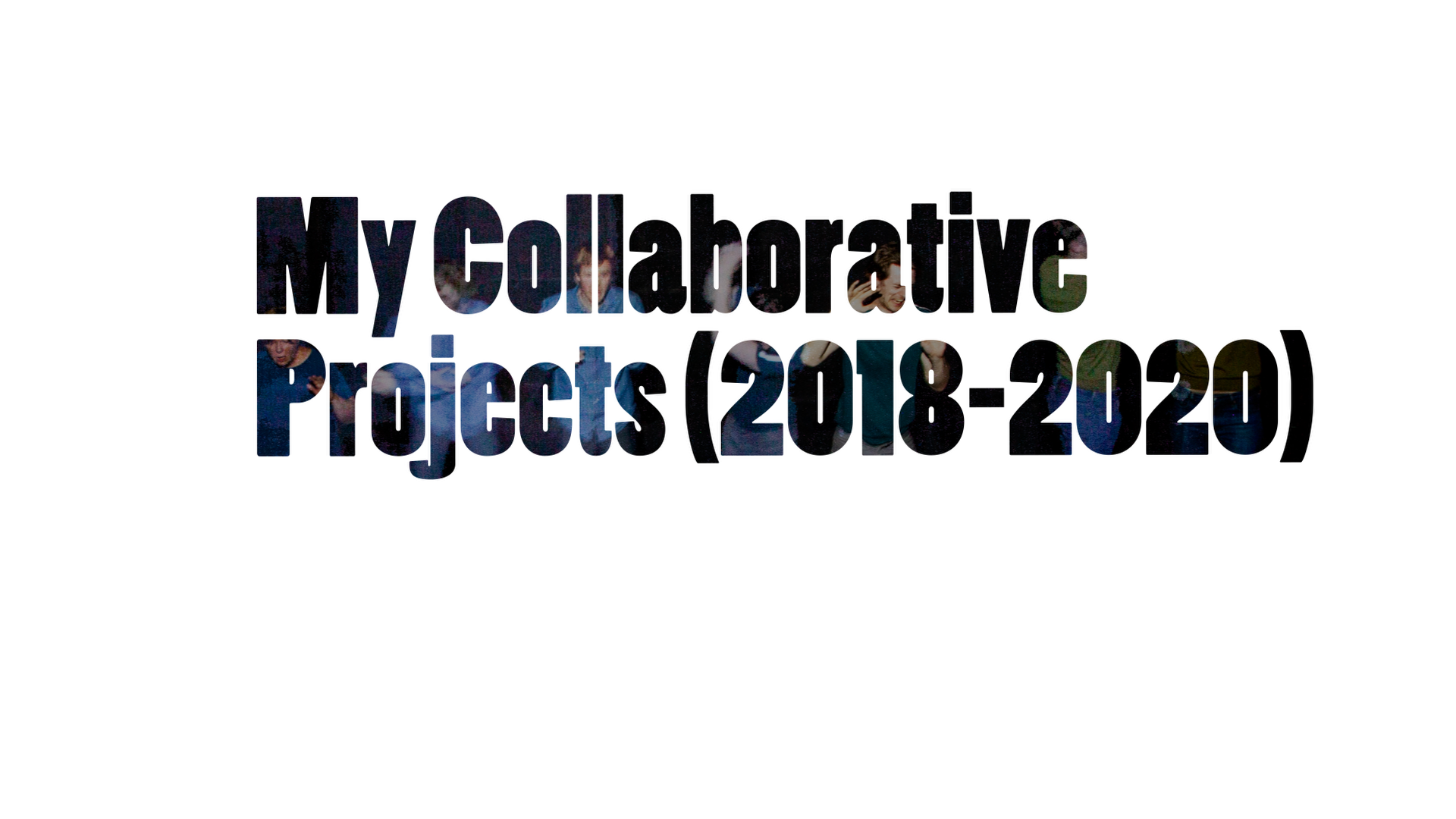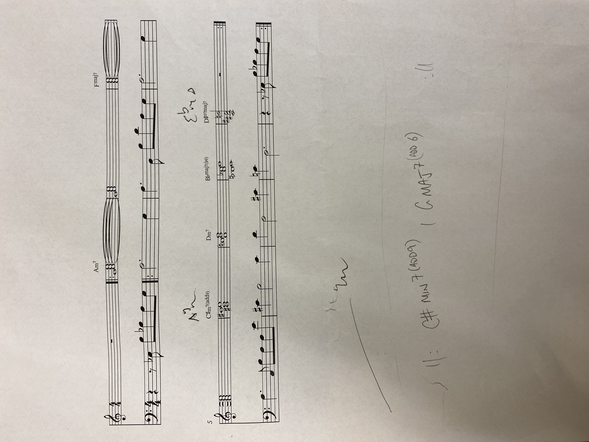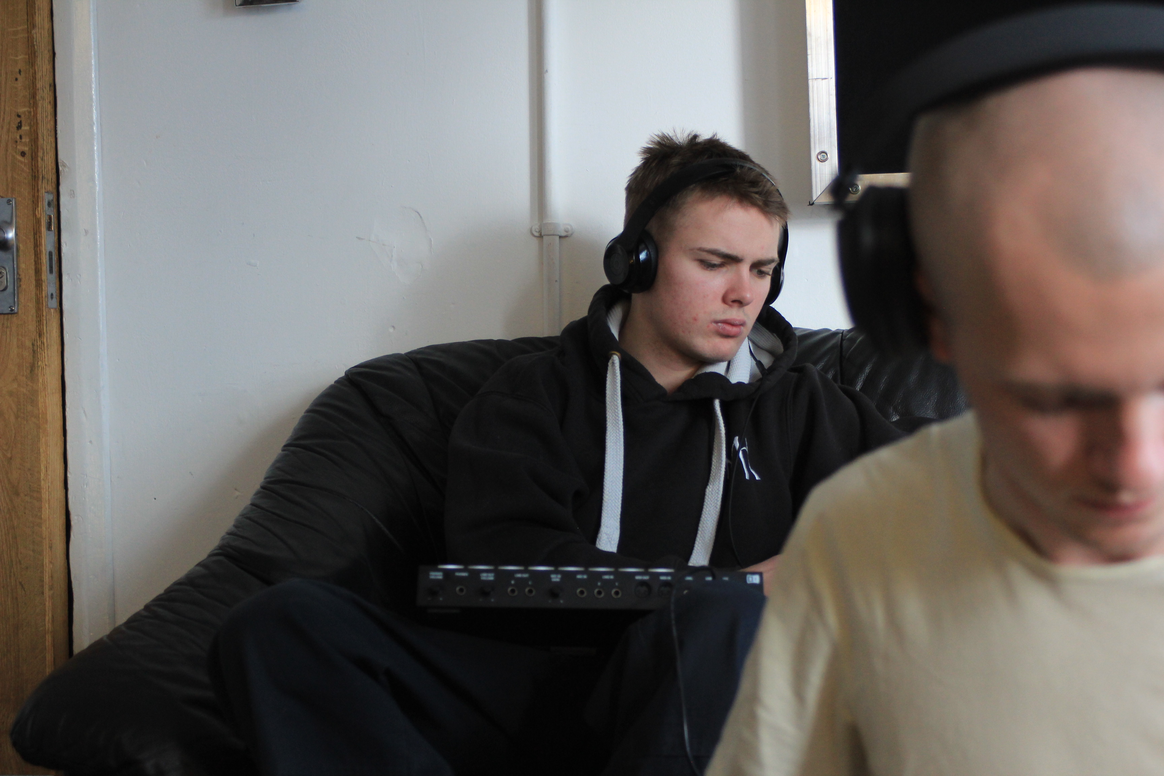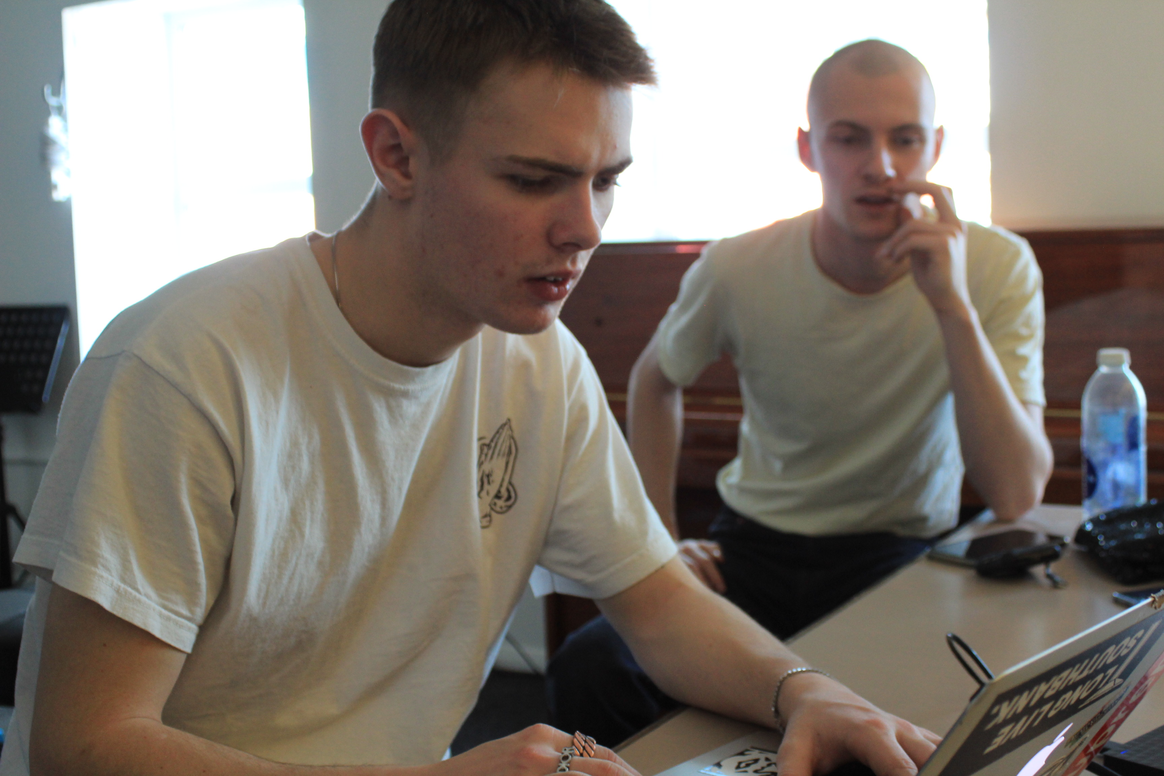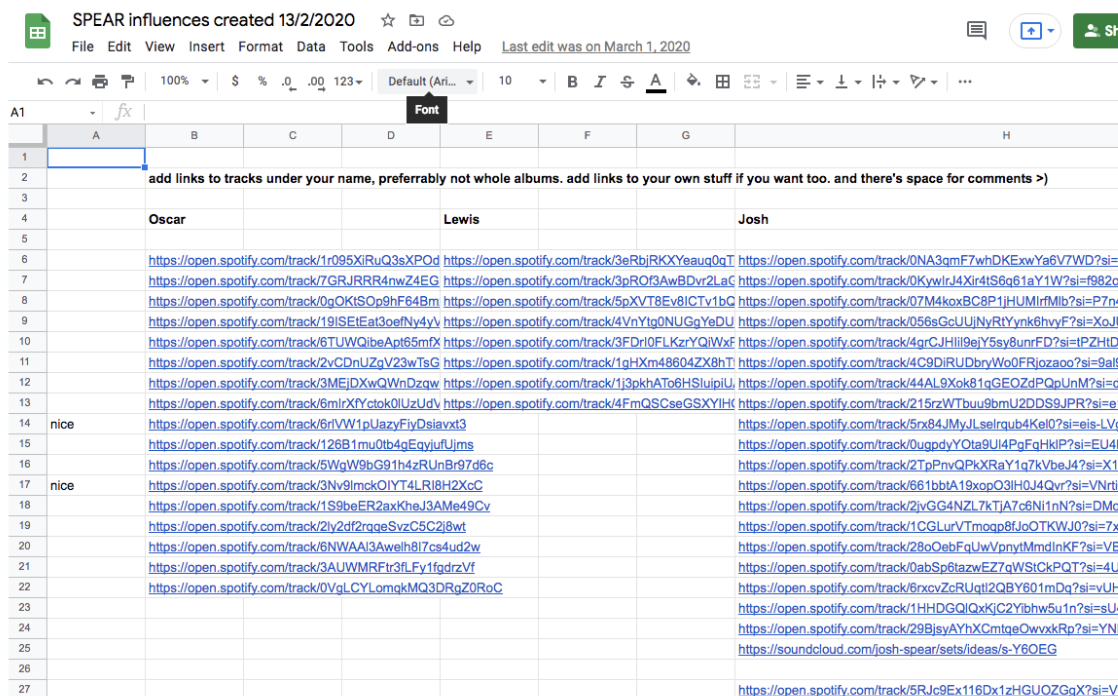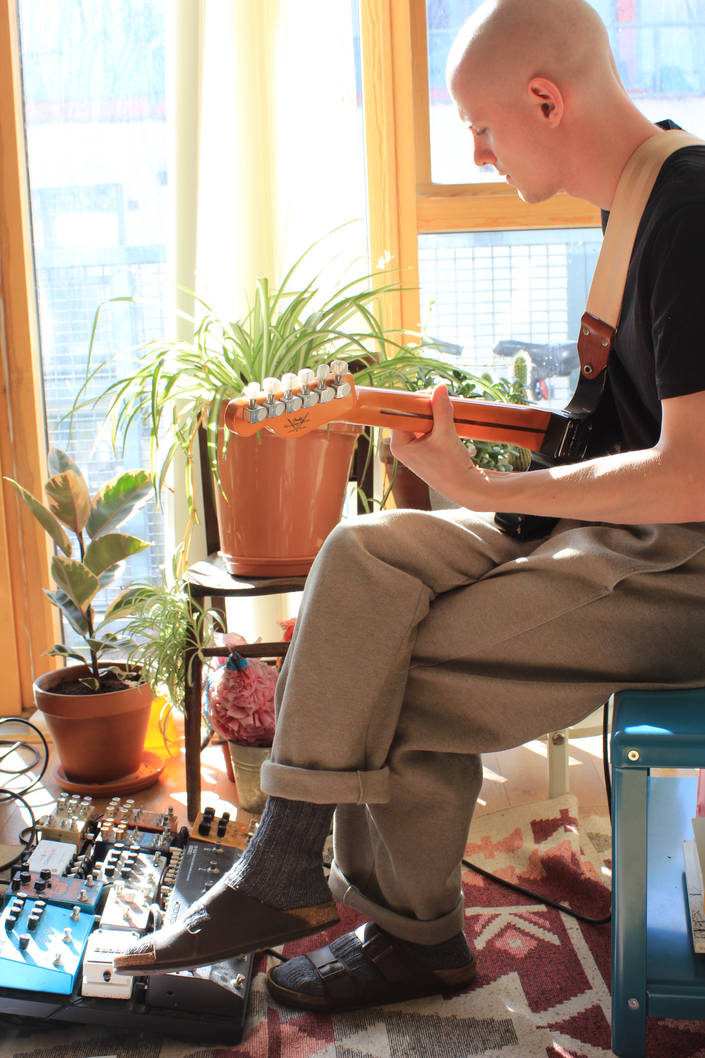Here is a short summary of what we (François, Oli and I) developed over the course of our ten or so days spent together. We experimented with the text, movement, amplification and the music that I created with Morten Qvenild.
“Brothers EP” (2020)
This EP of four tracks remains unfinished and was the last project to take place in person before the lockdown of 2020. I spent some days working with two of my younger half-brothers, Lewis and Oscar Spear. It was a collaboration not unlike the trajectory I trace with Bastard Assignments; I was happy with whatever would emerge creatively from this constellation of people. I view this constellation as a compositional choice.
*
Oscar creates Electronica, he is active as a DJ and is part of a duo called “Hotel Rubio”. Lewis is an electric guitarist with a lot of band experience. He has also performed with Bastard Assignments. Both have studied music at higher education level. At the time of recording, I was 29, Lewis was 25 and Oscar just 19. Lewis, Oscar and our other brother Felix all grew up in Spain.
*
Prior to meeting in early March of 2020, I initiated a document to collate music that we were interested in. I was attempting to create a shared imagination for what we would be working on. I asked Lewis and Oscar to add links to music that was important for them at that time so we could listen to each other’s influences.
On March 2nd 2020, I met with Lewis at his home in London where we began recording him playing some Guitar parts for two tracks that I was interested in working on with him. Again, I had already brought these ideas in the form of chords and how they would fit in a track; I would call this complementary or interactive collaboration.
On March 4th, I met with Oscar and showed him my rough assembly of ideas that I had recorded with Lewis. I had booked a day in a studio for March 6th for the three of us. Oscar and I began to get on the same page about what we would be doing then.
I present two tracks here that have emerged from this project as complete. We recorded guitar material for two additional tracks that remain incomplete and another improvisation that Oscar made use of separately from this project. One track called “130” is by Lewis Spear and Oscar Spear, the other, “It’s a Love” is by myself and features Lewis playing guitar as well as the sound of him playing a video game. Both of these songs were already formed from a harmonic point of view prior to our working period. The arrangement or structure of Lewis’ track “130” became the subject of collaborative working in the session. For example, “130” began in the time signature 3-4 but ended up in 4-4 in the final iteration, a change made by Oscar. The track in the original time signature is also presented here. Owing to his greater audio production skills, Oscar became burdened with finishing the tracks during the following months, which was not ideal. Indeed this remains an unfinished project however this is primarily due to circumstances. I consider the working period to have been successful probably because my interest or even compositional wish was to simply bring us all together in a creative context.
Much of the material was directed by me, or Lewis in the case of “130”. Lewis’ sound was almost always left open to him because it was his area of expertise. Oscar also requested that Lewis record something for him, which was successful insofar as Oscar gave Lewis free reign to improvise over a track - with harmonic structure, arrangement and speed already determined - and Oscar was pleased with the result.
The following audio clips are from our studio work day on March 6th. The audio clip below is an exchange after recording Lewis playing a musical idea of mine. Oscar made a useful suggestion drawing on a production technique that I was unaware of.
We began the session with recording Lewis playing Guitar before transforming the studio into a workspace with a desk, using the studio’s speakers as monitor speakers. We started to assemble “130”. There was a lot of off-task-talk throughout this day and humour that often materialised through singing. Cafferty and Clausen's (1997) idea of ‘off-task-talk’ is conversation that serves the building of trust, talk that is unrelated to the rehearsal or workshop but is an exchange of personal or humorous details.
The audio clip below is from when we first began to add a beat to Lewis’ material. Lewis offered an idea for the arrangement. We engaged in exploratory talk and evaluated ideas as a group. Oscar made suggestions for the beat and that included adding live recorded drums, which Lewis ran with as an idea and developed. He even suggested adding voices, which Oscar then took up. Humour ran throughout and much of it was in flow.
In the audio clip below we are discussing “It’s a love” as a group to see if we can do something to it there and then, concerning its arrangement and how to add a beat. We discussed how there needed to be some quantising in order for a beat to fit properly over it. Lewis and I recalled our shared ideology that understood the video game sound layer as a layer of percussion on its own. We flowed seamlessly from discussing how to layer a beat onto the track that develops, into a conversation about the structure of it before agreeing to leave it for now and segue into jamming over the beat. Oscar then smoothly changed the track, over which we were improvising, to something else of his.
In the clips below we are working on “130” again. Lewis was interested in adding quite a lot of noise to the introduction of the track. There was a combination of tastes. Oscar was tasked with controlling the laptop and was being directed by suggestions. The first clip shows us listening to the track as it was. Then we begin to suggest phrasing by vocalising a white noise sound. We had a shared imagination for this and collectively took up the suggestion and how it was best to create it; no one is in charge. Lewis has handed the song over to the group. In the second clip, Lewis suggests Oscar record his spanish rap, which is more of a joke than a serious rap but we were risk-taking, as per integrative collaborative, and flowing. Oscar recorded it but we did not end up using it.
The process was transformational and opened up new possibilities for us as a new group able to create together and improvise. The project built a new relatedness as musicians who are also brothers and in this way it was intimate. The clip below is from a spontaneous improvised period on top of one of Oscar’s tracks that he had already been working on. Lewis played guitar whilst I played keyboard. It is an example of talking in text which is something that the three of us had never done together before. It could be said that this day spent in the studio was an experiment, a test to see how we would work together, with the improvised moments acting as flagged passages. This gave us a new closeness by enriching our relationship as brothers and a working relationship that I wish to continue.
*
All of these projects were in-person. As I will show in the ‘Lockdown Collaborative Projects’ chapter, working online really tests the group’s commitment to the project and the trust between colleagues. In-person working allows for a broader spectrum of communication, offering greater clarity and nuance. In-person interactions also allow for off-task activities like eating that can happen in another place away from the pressure of the work. For me, it is useful to understand my choice of collaborators as a compositional choice because so many of the compositional decisions and the eventual work would in some way stem from this choice of personnel. From this perspective, matters of satiating my own artistic wants through the work or the need to get my own way become secondary. Similarly, anxiety about my compositional or musical ideas being used or discarded fall away because everything seems to already be part of my initial choice.
My openness to the discovery of new modes of collaboration has meant that, on reflection, I now understand cooking together with Ed, Tim and Caitlin at Snape Maltings as a new possible mode. John’s coaching on performance practice is another such mode of collaboration that has emerged as new to me. Instances of talking in text, particularly in the spontaneous improvised session with my brothers, unrelated to the task, or the group score-drawing with Bastard Assignments amounting to role-sharing, have shown themselves to be highly valuable and significant in the course of this critical reflection. That there are different modes of collaboration beyond the creation and interpretation of a score is crucial to what I am trying to communicate and even that each project brings with it its own project-specific modal potentialities.
The multimodality of collaboration then emerges as an idea here. The inclusivity of a multimodal approach is in opposition to the exclusivity of a textual approach; it anticipates an emerging group process rather than a predetermined ideology. It produces shared authorship by understanding every mode as contributing to the whole.
The score can be understood as one root for sharing knowledge or doing communication amongst other modes. The emergence of different modes is affected by the particular constellation of people involved in undertaking the task. To use an example, although spoken language shares many features of written text, and are used to communicate between people, they are quite different modes of communication. Speaking is heard rather than read and is made up of different parameters like loudness, pitch and tone, which can be controlled to give deeper meaning to language (Jewitt, 2009, p.62). Writing has to be read from left to right and can exist long after it is written. So speaking and writing are as distinct as they are similar. People will generally communicate in both spoken and written modes but they usually happen at different times and spaces to different ends.
To begin with the assumption that two or more parties are willingly contributing to the creation of a piece that has a score, the primary mode of collaboration, I must also assume that they are enabled because of the foundation of trust and context of collaborative work, risk-taking and shared vision. This foundation will be supported by events and interactions at different times and spaces that are not solely focussed on the production of the work but also strengthen the professional and personal relationships of the parties. Modes are supplementary to one another and particularly to the primary mode, in that they produce this essential foundation. These interactions are quite indistinguishable from the overall project; the collaborative project is formed of all of the modes that can be identified within it. Talk about the work happens outside and inside of rehearsals. Trust and rapport are built over meals and through schedule-keeping. Improvisation in performance is an example of a mode of a collaboration as is the post-production stage of a project. Observing the emergence of these modes is an outcome of the view that I have taken for this RP.
To refer back to the example of “FEED”, amidst largely directive working there were moments of integrative collaborative working where my colleagues in Bastard Assignments became co-creators. This was through the shared imagination for the section and a shared evaluation of the results. Surrounding this period was the buying, preparing and cooking of meals, driving and evenings spent in the pub together whilst on residency. Our funding applications for this and projects like it are always a collaborative effort. Later in the process of “FEED” during preparation for performance, the job of director fell not only to me but was taken up by the others for moments, making the interpretation of the piece an integrative collaborative effort also. Each of these are different modes that form a whole and are visible when a view wider than a score is cast over a project. Much like a piece of rope, a working partnership is reinforced by the intertwining of these different modes. Heather Roche writes that an intimate collaboration can become like a line connecting those involved, together with the work produced (Roche, 2011, p.14). It creates an interior text that is constantly evolving and changing long after the physical text is completed or even if the physical text never emerges.
This idea takes a longer term perspective to the research outcomes arrived at by Sam Hayden and Luke Windsor in their paper: “Collaboration and the Composer: Case Studies from the End of the 20th Century”. Hayden and Windsor (2007) conclude that a collaborative process does not mean a more successful artistic product just as an unsuccessful process does not imply an unsuccessful product. My comment on this is two-fold: a successful collaboration might not result in a successful piece but it is more likely to produce further collaborations between those partners; and in this way, I am wary of Hayden and Windsor’s strong delineation between process and product. Products could be considered part of the process and the longevity and success of the process as a product. If there is a bad collaboration, I do not believe the work to automatically be flawed; I take a more pragmatic approach and reason that it is unlikely that that partnership will produce work again. Like this, collaboration becomes social and Rogoff (1990) reminds us that “The mutual involvement of people working on similar issues is part of the social context of creativity.” (Rogoff, 1990, p.199).
Hayden and Windsor also support certain aspects of this research, notably on integrative collaboration, through the claim that successful collaborations occurred when the process arose as an idea of the group rather than as a predetermined ideology and also that a shared aesthetic goal seemed important; both of these amount to a shared vision brought about through dialogue (Hayden & Windsor, 2007, p.38).
“Loretta Strong” (2019)
In contrast to working with John and even Bastard Assignments, in theatre it seems it is important to begin with a shared imagination of what the piece is going to be.
*
Oliver Dawe is a theatre director. He and I both went to the same school and are the same age. We have worked together on a number of productions in London.
François Testory is a legendary performer. He started his career as a dancer training at Mudra the Maurice Béjart School of Performing Arts in Brussels. He then joined the Lindsay Kemp Company. He has worked with many companies including Ballet Rambert, Rose English, David Glass Ensemble and DV8 Physical Theatre. He has also sung with Medieval Polyphony ensembles. I first saw him perform in Punchdrunk’s “The Drowned Man”. He initially approached me with “Loretta Strong” and a desire to work on it in 2018.
Morten Qvenild is a pianist and artistic researcher born in 1978. He has toured with “a-ha”. He has also completed the artistic research fellowship and works at NMH as an associate professor of jazz piano.
*
In September 2019, I invited Oli and performer François Testory to spend a week in Oslo working on our version of the play, “Loretta Strong” (1974) by Copi, also known as Raúl Damonte Botana (1939-1987). I present this part of the reflection as audio. The project also features pianist Morten Qvenild.
